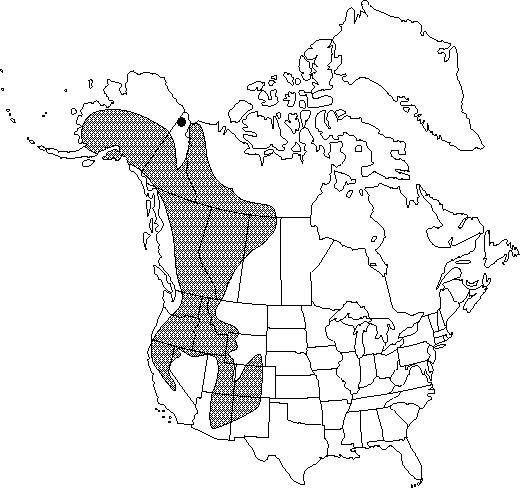Alnus incana subsp. tenuifolia
Amer. Midl. Naturalist 58: 25. 1957.
Shrubs or trees, to 12 m; shrubs ascending, open, spreading, trees small, shrubby. Bark light gray to dark brown, smooth; lenticels pale, orbiculate to elliptic. Winter buds nearly divergent, ellipsoid, 4–7 mm, apex obtuse; stalks 1–3 mm; scales 2, equal, valvate. Leaf blade ovate to elliptic, 4–10 × 2.5–8 cm, thin, base broadly cuneate to rounded, margins distinctly doubly serrate to nearly crenate or lobulate, teeth relatively blunt or rounded, apex acute to obtuse; surfaces abaxially glabrous to sparsely pubescent, slightly to not noticeably resin-coated. Inflorescences: staminate catkins in 1 or more clusters of 3–5, 4–10 cm; pistillate catkins in 1 or more clusters of 2–5. Infructescences ovoid, 1–2 × 0.8–1.3 cm; peduncles 1–5 mm. 2n = 28.
Phenology: Flowering early spring.
Habitat: Stream banks, lake shores, margins of wet fields and meadows, bog margins, and muskegs
Elevation: 100–3000 m
Distribution

Alta., B.C., N.W.T., Sask., Yukon, Alaska, Ariz., Calif., Colo., Idaho, Mont., Nev., N.Mex., Oreg., Utah, Wash., Wyo.
Discussion
Alnus incana subsp. tenuifolia is somewhat more treelike than the eastern A. incana subsp. rugosa, from which it also differs in leaf shape, leaf margins, and other characters. It is a frequent component of streamside vegetation throughout the Rocky Mountains and other mountainous parts of western North America.
Native Americans used alnus incana subsp. tenuifolia medicinally for pains in the lungs or hips, for scrofula, as a laxative, and as a diuretic for gonorrhea (D. E. Moerman 1986).
Selected References
None.